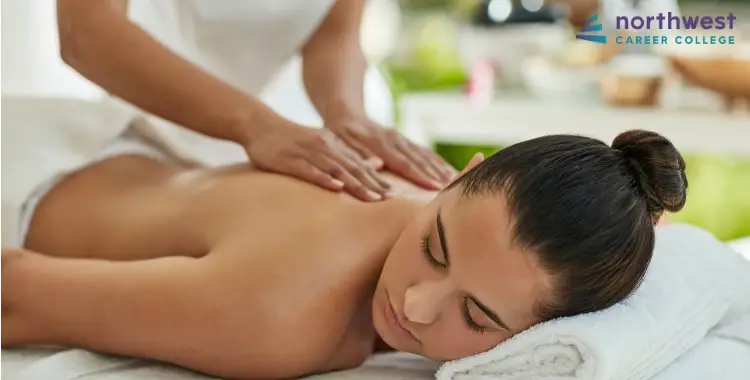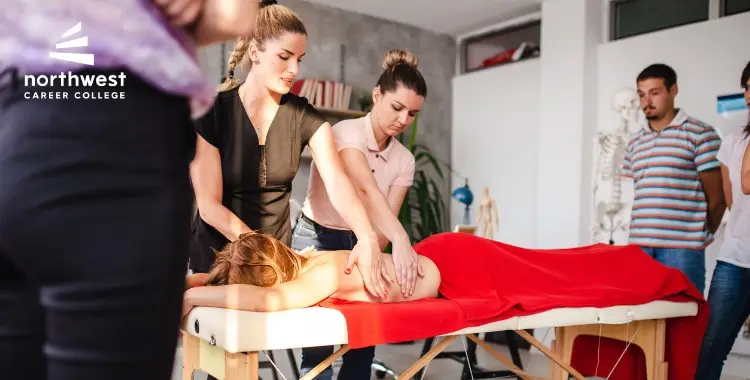A Beginner’s Guide to Deep Tissue Massage
- Massage Therapy
- February 25, 2025
- 4.6k views
- 6 min read

Have you ever wondered what makes a “deep tissue” massage different than a normal Swedish massage? You are not alone. Many people who have never received a massage are intimidated or confused by the different massage techniques. Others have received Swedish massages but never tried deep tissue because they feared the “pain” associated with this technique. This article will give you a brief overview of what “deep tissue” means, what it is “not,” and an idea about whether or not it’s a good fit for you!
Table of Contents
What is a deep tissue massage?
So, what is deep tissue? And how does it differ from a regular massage? These are great questions. A deep tissue massage focuses primarily on deep layers of muscle that lie underneath other muscles. These deeper layers of muscle tissue are often the root cause of tension and discomfort felt throughout the body. Deep tissue techniques aim to reduce or eliminate knots in these areas.
Deep tissue massage typically relies on slow, deliberate strokes. Often, deep tissue will use static pressure on areas of tension, only moving to a new spot after staying in place for an extended period of time. Deep tissue is also characterized by firmer pressure. This firmer pressure is more likely to yield muscle relaxation than lighter pressure, especially in deep muscle fibers.
Deep tissue techniques aim to improve blood flow to areas of tension and release fascia, the connective tissue surrounding your muscles. Both of these effects promote the relaxation of tense muscles. Additionally, deep tissue can physically separate muscle fibers and reduce adhesions by applying cross-fiber friction. In this technique, you massage perpendicular to the muscle fibers instead of the usual parallel approach (used in Swedish massage).
Expect a little discomfort (but in a good way)
Many people are nervous about getting deep tissue massages because they have heard they can be uncomfortable or even painful. While it is true that these massages can be a bit uncomfortable at times, it’s the “hurts so good“ sort of discomfort… It should not be truly painful. If it is, you should ask your therapist to lighten up on the pressure.
Your therapist uses firm pressure to release tension and adhesions in your muscles. When firm pressure is applied to a particularly stubborn knot, your body can react by referring pain or other sensations, such as tingling, towards remote parts of the body. For example, a knot in your shoulder can cause pain in your head when pressure is applied. These “referral patterns” can be somewhat predictable based on specific neuromuscular patterns.
Although this discomfort can be distracting for some, it typically makes you feel fantastic afterward, as this is the most effective way for many people to get pain relief from hypertonic muscles. You must also remember that many knots have taken years to build up to their current level. Therefore, it is likely to take a significant amount of work to correct the imbalances that your therapist finds.
Other Considerations for the Session
During a deep tissue massage, your therapist may use different techniques than you are used to to address different muscle groups. They may also work on muscles you have never felt somebody massage before… For example, there are small muscles between the vertebrae of your spine or on the back of your shoulder blade that are not typically focused on during Swedish massage but may provide significant pain relief during a deep tissue massage.
Other techniques that may differ from previous massages you have received include static pressure that focuses on a trigger point (a point of significant tightness and tenderness) or friction, applied either with or against the grain of the muscles. Therapists often alternate between static pressure and friction to maximize their impact on a trigger point.
Therapists may also use their knuckles, elbows, or forearms to apply pressure. These allow them to increase their leverage significantly when working on larger muscles. It also allows them to save their hands and thumbs for when they need to be more precise with their pressure.
An important thing to note is that if you have a particular trouble spot that has been bothering you, don’t forget to mention it. Deep tissue massage focuses on specific areas, so communicating them to your therapist will empower them to provide a successful session.
Drink water and stay loose.
After a deep tissue massage, you must stay hydrated. After your session, your muscles will be detoxing. You will have increased circulation to the muscles that were worked on, and that blood flow will be flushing out the buildup of lactic acid typically found in knots out of your muscles and into your bloodstream.
Drinking lots of water after such a session will help your body flush the lactic acid out of your bloodstream. This is key to minimizing post-massage soreness. Hydrating your muscles also helps them stay supple and loose, locking in the benefits of your treatment.
It’s also a good idea to rest for a while after your massage. It is typically recommended that you avoid strenuous activities right after your massage so that your body can benefit from the treatment you received. Usually, you should take it easy the rest of the day.
In conclusion, the benefits are worth it.
Deep tissue massage offers a number of essential benefits. It can help alleviate chronic pain and reduce stress. By doing so, it can also help you improve your posture. It can break down scar tissue when applied properly. It can even help improve your mental well-being.
Think of it as a reboot for your muscles and your mind. Releasing muscle tension can reduce mobility restrictions and allow you to move freely and without pain. By alleviating pain, it can inspire a sense of rejuvenation and relaxation after your treatment, reducing stress and anxiety.
If you are considering a deep tissue massage after reading this guide, it’s time to give it a shot. What are you waiting for? Your muscles will thank you, as you will be well on your way to a more relaxed, tension-free version of yourself.





